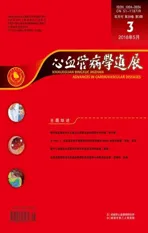心房颤动与钠尿肽家族最新研究进展
2018-02-12张舒珊综述杨延宗审校
张舒珊 综述 杨延宗 审校
(中山大学附属第五医院,广东 珠海 519000; 2.大连医科大学附属第一医院心内科,辽宁 大连 116000)
心房颤动是心房无序激动和无效收缩的心律失常疾病,其发病机制复杂,研究表明心房重构、神经内分泌激素、细胞因子、炎症及基因等因素共同参与[1]。心房重构是心房颤动发生、发展的核心环节[2],心房电重构和解剖重构是心房颤动发生和维持的基础。近些年来,越来越关注神经内分泌机制对于心房颤动上游治疗的应用,其中肾素-血管紧张素系统对于心房颤动发作的促进作用已经得到证实,但钠尿肽(natriuretic peptides,NPs)家族作为最早发现起源于心脏循环的激素,其对于心房颤动影响的机制尚不明确,以下将从NPs家族对心房颤动的电重构、解剖重构以及NPs在心房颤动领域的应用价值三个方面作一阐述。
1 NPs家族对于心房电重构的影响
NPs家族是一组具有利尿利钠、舒张血管降压、抗细胞增殖等活性的多肽,主要包括心房钠尿肽(atrial natriuretic peptide,ANP)、脑钠尿肽(brain natriuretic peptide,BNP)、 C型钠尿肽(C-type natriuretic peptide,CNP)和D型钠尿肽(D-type natriuretic peptide,DNP)。已知在人类NPs中均含有一个特定的由17个氨基酸组成的环状结构,由其中2个半胱氨酸残基通过二硫键形成的环状结构,该结构与受体结合为其活性中心。NPs有3种受体,NPR-A、NPR-B、NPR-C受体。ANP、BNP 与NPR-A相结合使第二信使环磷酸鸟苷(cGMP)水平升高,促使cGMP下游信号分子蛋白激酶G(PKG)、磷酸二酯酶激活,使细胞膜离子通道的靶点磷酸化,发挥改变离子通道的作用。此外基因学研究已经证实了NPs突变与人类遗传性心律失常疾病密切相关[3]。快速连续不规则的心房刺激可导致动作电位时程和有效不应期的缩短,其中钙超载是电重构的核心,细胞内的钙超载会使细胞开启自我保护机制,通过钙离子通道失活以及钙通道蛋白表达下调等减少钙离子内流。L型钙离子通道是NPs调节离子通道的主要靶点,在体外兔及大鼠的心室肌细胞中,NPs家族(ANP、BNP、DNP)通过cGMP-PKG信号通路降低L型钙通道电流(ICa-L)[4-5]。在大鼠的心室肌细胞中,BNP、CNP降低L型钙离子通道表达,在细胞内钙循环、钙的瞬移等方面起到关键作用[6]。有研究显示cGMP能激活的肌质网Ca2+-ATP酶,导致细胞内Ca2+浓度下降。药理学的研究显示减轻细胞内钙负荷可逆转电重构,钙离子的不稳定和分布异常促进心房颤动的发展。虽然NPs导致ICa-L减少使动作电位时程和有效不应期缩短,从生理功能分析,细胞内的钙超载导致钙循环的异常、细胞内外的离子紊乱和迟后除极而诱发心肌电紊乱,NPs减轻细胞内钙超载更有利于细胞稳态的保持,避免心肌电紊乱。一些研究也证实NPs对其他离子通道电流调节的作用,其中包括钠电流(INa),超极化激活电流(If),钾电流包括瞬时外向钾电流(Ito),延迟整流钾电流(IKs)和ATP敏感的钾电流(IK·ATP)。ANP可增加心肌细胞中的If[7],If是4期主要的去极化电流,If内流速度加快使窦房结自律性的增加,降低心房肌异位搏动和降低心律失常的发生率[2]。Lin等[8]研究得出在体外兔心肌细胞中,灌注BNP,可增加If、Ito、INa、INa-Ca和ICa-L等。但Hua等[9]的研究中ANP对于鼠心肌细胞INa通道无影响,BNP、CNP可调节体外的鼠心室肌细胞IK·ATP通道[10]。根据目前现有的研究推测不同物种、不同的基础状态,NPs对心脏电生理及离子通道的表达具有双向调节的作用,主要是由于cGMP复杂的下游信号级联反应所致。一旦NPR-B-GMP-PKG与 NPR-A-GMP-PKG信号通路被激活,一系列下游的潜在通路被激发。NPs可以同单一的NPR结合,也可以同多个NPR结合形成多种交互的信号通道,目前这些通路尚不清楚。综上,NPs对于心房颤动电重构的影响目前仍不清楚。
2 NPs家族对于解剖重构的影响
心房解剖重构主要表现为心房收缩力下降、肌细胞超微结构改变和纤维化;其中纤维化是心律失常结构性重构最为突出的改变。ANP、BNP通过排钠排尿,舒张血管的作用减轻心脏前后负荷而抑制心脏重构的基础上,其在心脏局部也起到更为直接抗心肌纤维化的作用。Lin等[11]实验发现心肌细胞、成纤维细胞均存在NPs受体,心肌细胞表面主要有NPR-A,心肌成纤维细胞表面同时存在NPR-A、NPR-B,在一般情况下,NPs受体在心房表达水平高于心室[12]。在扩张型心肌病的小鼠中,ANP可有效改善心功能、降低死亡率。在ANP基因缺失的小鼠中,其后代更容易获得心肌肥厚[13]。ANP和BNP通过调节以下关键要素抑制心肌纤维化:(1)调节心脏的肾素-血管紧张素-醛固酮系统。ANP、BNP通过抑制心肌细胞醛固酮,抑制心脏局部的肾素-血管紧张素-醛固酮系统[14]。Nakagawa等[15]发现ANP及其下游信号通路调节盐皮质激素受体核转位和转录活性,抑制醛固酮合成而发挥抗纤维化、逆转心脏扩张及心力衰竭的作用。(2)调节转化生长因子(TGF)-β信号通路。有研究证实BNP具有对抗TGF-β因子介导的纤维化、心肌成纤维细胞的转化、细胞增殖及炎症等作用[16]。一项体外小鼠成纤维细胞中,ANP抑制TGF-β诱导的心肌成纤维细胞外基质的表达[17]。(3)调节转录因子GATA4,在缺失NPR-A基因的小鼠中通过PKC-MAPK-GATA4通路导致心肌纤维化。Glenn等[18]研究的心房NPs抑制心肌成纤维细胞内皮素基因表达和细胞增殖,通过GATA4介导的信号通道。(4)调节细胞内酶和G蛋白偶联受体信号。Tokudome等[19]报道缺失鸟苷酸环化酶的小鼠可抑制心肌肥厚。
3 NPs家族与心房颤动相互作用及临床价值
影响ANP、BNP水平的重要因素是左心房壁的牵拉、跳动频率紊乱、射血分数降低等,上述生理学变化导致心房膨胀及心房内压急剧升高,促使以ANP为主的NPs家族分泌增加;另外的一些因素包括心动过速、跨壁压力、甲状腺激素、糖皮质激素、血管活性肽内皮素和血管紧张素Ⅱ等。Rossi等[20]发现心房颤动患者ANP的升高不依赖左心房容量和左心室射血分数,认为ANP升高是心房颤动发生的独立危险因素。心房颤动与窦性心律患者相比,ANP、BNP水平显著升高[21],有研究显示高水平ANP可预测阵发性心房颤动发展为充血性心力衰竭或心脏术后预后情况[22]。另一项研究显示高水平ANP与二尖瓣置换及迷宫术后心房颤动发生率呈正相关[23]。高水平ANP与心房颤动发作时心房压力急性生理反应相关,恢复窦性心律后高水平ANP可能较前下降[24]。然而也有研究指出恢复窦性心律的持续性心房颤动患者,一个月后ANP仍处于高水平[25],原因可能与虽然左房压力较前明显下降,左心房的机械性牵拉依然存在。另一些研究显示低水平的ANP较难维持窦性心律[26],原因可能与长程持续性心房颤动,心房发生解剖重构导致功能细胞丢失和ANP分泌的降低有关。在评估心房颤动消融术后复发的研究中血浆BNP、BNP前体(NT-proBNP)水平较高的患者心房颤动的复发率较高[27]。一项包含十项荟萃分析的研究中高水平BNP与射频导管消融术后心房颤动风险增加相关,认为血浆BNP水平是心房颤动患者射频导管消融术后复发的独立观测指标[28]。心房颤动组经过射频导管消融术后24 d 血中BNP水平明显下降,在3个月的时间内均处于下降趋势[29]。BNP和NT-proBNP水平已被证实可预测不同的临床环境中发生心房颤动的风险。血浆中高水平NT-proBNP可预测行体外循环冠状动脉旁路移植术的患者术后发生心房颤动的情况[30],另一项研究中高水平的BNP可预测2型糖尿病人群心房颤动的发生率[31]。故目前认为NPs是评估心房颤动病情、选择最佳治疗方案、预测消融手术、电复律成功率、心房颤动相关并发症发生率及死亡率等的重要指标[32]。
4 总结
在过去的20年间,NPs家族的临床应用已经不仅仅局限于心力衰竭的诊断标志物,作为具有保护作用的心血管起源生物活性肽激素具有逆转心脏重构的作用。现有的研究已经证实了NPs家族与心房颤动的发生息息相关,对于调节心脏电生理和心律失常的发作起到关键的作用。但NPs与心房颤动的相关性仍需进一步的基础研究以及大规模的前瞻性临床研究,这对阐明心房颤动的发病机制、危险分层、判定预后以及治疗心房颤动的新药研发均具有重要意义。
[ 参 考 文 献 ]
[1] Woods CE,Olgin J.Atrial fibrillation therapy now and in the future:drugs,biologicals,and ablation[J].Circ Res,2014,114(9):1532-1546.
[2] Xu Y,Sharma D,Li G,et al.Atrial remodeling:new pathophysiological mechanism of atrial fibrillation[J].Med Hypotheses,2013,80(1):53-56.
[3] Abraham RL,Yang T,Blair M,et al.Augmented potassium current is a shared phenotype for two genetic defects associated with familial atrial fibrillation[J].J Mol Cell Cardiol,2010,48(1):181-190.
[4] Perrin MJ,Gollob MH.The role of atrial natriuretic peptide in modulating cardiac electrophysiology[J].Heart Rhythm,2012,9(4):610-615.
[5] Fares N,Nader L,Saliba Y,et al.B-type natriuretic peptide modulates the action potential and the L-type calcium current in adult rat heart muscle cells[J].J Med Liban,2010,58(4):222-227.
[6] Azer J,Hua R,Krishnaswamy PS,et al.Effects of natriuretic peptides on electrical conduction in the sinoatrial node and atrial myocardium of the heart[J].J Physiol,2014,592(5):1025-1045.
[7] Lonardo G,Cerbai E,Casini S,et al.Atrial natriuretic peptide modulates the hyperpolarization-activated current(If)in human atrial myocytes[J].Cardiovasc Res,2004,63(3):528-536.
[8] Lin YK,Chen YC,Chen YA,et al.B-type natriuretic peptide modulates pulmonary vein arrhythmogenesis:a novel potential contributor to the genesis of atrial tachyarrhythmia in heart failure[J].J Cardiovasc Electrophysiol,2016,27(12):1462-1471.
[9] Hua R,MacLeod SL,Polina I,et al.Effects of wild-type and mutant forms of atrial natriuretic peptide on atrial electrophysiology and arrhythmogenesis[J].Circ Arrhythm Electrophysiol,2015,8(5):1240-1254.
[10] Burley DS,Cox CD,Zhang J,et al.Natriuretic peptides modulate ATP-sensitive K(+)channels in rat ventricular cardiomyocytes[J].Basic Res Cardiol,2014,109(2):402-404.
[11] Lin X,Hanze J,Heese F,et al.Gene expression of natriuretic peptide receptors in myocardial cells[J].Circ Res,1995,77(4):750-758.
[12] Egom EE,Vella K,Hua R,et al.Impaired sinoatrial node function and increased susceptibility to atrial fibrillation in mice lacking natriuretic peptide receptor C[J].J Physiol,2015,593(5):1127-1146.
[13] Armstrong DW,Tse MY,O’Tierney-Ginn PF,et al.Gestational hypertension in atrial natriuretic peptide knockout mice and the developmental origins of salt-sensitivity and cardiac hypertrophy[J].Regul Pept,2013,186:108-115.
[14] Miura S,Nakayama A,Tomita S,et al.Comparison of aldosterone synthesis in adrenal cells,effect of various AT1 receptor blockers with or without atrial natriuretic peptide[J].Clin Exp Hypertens,2015,37(5):353-357.
[15] Nakagawa H,Mizuno Y,Harada E,et al.Brain natriuretic peptide counteracting the renin-angiotensin-aldosterone system in accelerated malignant hypertension[J].Am J Med Sci,2016,352(5):534-539.
[16] Kapoun AM,Liang F,O’Young G,et al.B-type natriuretic peptide exerts broad functional opposition to transforming growth factor-beta in primary human cardiac fibroblasts:fibrosis,myofibroblast conversion,proliferation,and inflammation[J].Circ Res,2004,94(4):453-461.
[17] Li P,Wang D,Lucas J,et al.Atrial natriuretic peptide inhibits transforming growth factor beta-induced Smad signaling and myofibroblast transformation in mouse cardiac fibroblasts[J].Circ Res,2008,102(2):185-192.
[18] Glenn DJ,Rahmutula D,Nishimoto M,et al.Atrial natriuretic peptide suppresses endothelin gene expression and proliferation in cardiac fibroblasts through a GATA4-dependent mechanism[J].Cardiovasc Res,2009,84(2):209-217.
[19] Tokudome T,Kishimoto I,Horio T,et al.Regulator of G-protein signaling subtype 4 mediates antihypertrophic effect of locally secreted natriuretic peptides in the heart[J].Cardiovasc Res,2009,84(2):209-217.
[20] Rossi A,Enriquez-Sarano M,Burnett JC,et al.Natriuretic peptide levels in atrial fibrillation:a prospective hormonal and Doppler-echocardiographic study[J].J Am Coll Cardiol,2000,35(5):1256-1262.
[21] Xing SY,Wang HL,Dong PS,et al.Clinical significance and levels of blood brain natriuretic peptides in patients with persistent atrial fibrillation before and after catheter ablation[J].Genet Mol Res,2015,14(2):6953-6959.
[22] Yilmaz MB,Erbay AR,Balci M,et al.Atrial natriuretic peptide predicts impaired atrial remodeling and occurrence of late postoperative atrial fibrillation after surgery for symptomatic aortic stenosis[J].Cardiology,2006,105(4):207-212.
[23] Park J,Lee SH,Lee JS,et al.High recurrence of atrial fibrillation in patients with high tissue atrial natriuretic peptide and amyloid levels after concomitant maze and mitral valve surgery[J].J Cardiol,2017,69(1):345-352.
[24] Arakawa M,Miwa H,Noda T,et al.Alternations in atrial natriuretic peptide release after DC cardioversion of non-valvular chronic atrial fibrillation[J].Eur Heart J,1995,16(7):977-985.
[25] Bernard-Brunet A,Saint Etienne C,Piver E,et al.Incomplete recovery of mechanical and endocrine left atrial functions one month after electrical cardioversion for persistent atrial fibrillation:a pilot study[J].J Transl Med,2014,12:51.
[26] Govindan M,Borgulya G,Kiotsekoglou A,et al.Prognostic value of left atrial expansion index and exercise-induced change in atrial natriuretic peptide as long-term predictors of atrial fibrillation recurrence[J].Europace,2012,14(9):1302-1310.
[27] Fan J,Cao H,Su L,et al.NT-proBNP,but not ANP and C-reactive protein,is predictive of paroxysmal atrial fibrillation in patients undergoing pulmonary vein isolation[J].J Interv Card Electrophysiol,2012,33(1):93-100.
[28] Zografos T,Maniotis C,Katsivas A,et al.Relationship between brain natriuretic peptide and recurrence of atrial fibrillation after successful electrical cardioversion:a meta-analysis[J].Pacing Clin Electrophysiol,2014,37(11):1530-1537.
[29] Arana-Rueda E,Pedrote A,García-Riesco L,et al.Clinical value of N-terminal pro-B-type natriuretic peptide measurement in the follow up of pulmonary vein ablation[J].Med Clin(Barc),2015,145(6):248-250.
[30] Lednev PV,Belov YV,Komarov RN,et al.The role of N-terminal pro-brain natriuretic peptide in prediction of postoperative atrial fibrillation[J].Khirurgiia(Mosk),2016,(1):4-14.
[31] Kishimoto I,Makino H,Ohata Y,et al.Impact of B-type natriuretic peptide(BNP)on development of atrial fibrillation in people with type 2 diabetes[J].Diabet Med,2016,33(8):1118-1124.
[32] Hijazi Z,Oldgren J,Siegbahn A.Application of biomarkers for risk stratification in patients with atrial fibrillation[J].Clin Chem,2017,63(1):152-164.
